SNAS334F August 2005 – November 2015 ADC128S022
PRODUCTION DATA.
7 Detailed Description
7.1 Overview
The ADC128S022 is a successive-approximation analog-to-digital converter designed around a charge-redistribution digital-to-analog converter.
Simplified schematics of the ADC128S022 in both track and hold operation are shown in Figure 34 and Figure 35 respectively. In Figure 34, the ADC128S022 is in track mode: switch SW1 connects the sampling capacitor to one of eight analog input channels through the multiplexer, and SW2 balances the comparator inputs. The ADC128S022 is in this state for the first three SCLK cycles after CS is brought low.
Figure 35 shows the ADC128S022 in hold mode: switch SW1 connects the sampling capacitor to ground, maintaining the sampled voltage, and switch SW2 unbalances the comparator. The control logic then instructs the charge-redistribution DAC to add or subtract fixed amounts of charge to or from the sampling capacitor until the comparator is balanced. When the comparator is balanced, the digital word supplied to the DAC is the digital representation of the analog input voltage. The ADC128S022 is in this state for the last thirteen SCLK cycles after CS is brought low.
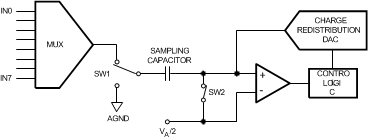 Figure 34. ADC128S022 in Track Mode
Figure 34. ADC128S022 in Track Mode
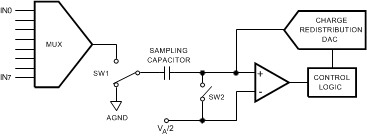 Figure 35. ADC128S022 in Hold Mode
Figure 35. ADC128S022 in Hold Mode
7.2 Functional Block Diagram
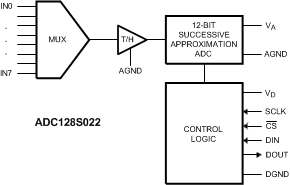
7.3 Feature Description
7.3.1 Serial Interface
An operational timing diagram and a serial interface timing diagram for the ADC128S022 are shown in the Specifications section. CS, chip select, initiates conversions and frames the serial data transfers. SCLK (serial clock) controls both the conversion process and the timing of serial data. DOUT is the serial data output pin, where a conversion result is sent as a serial data stream, MSB first. Data to be written to the ADC128S022's Control Register is placed on DIN, the serial data input pin. New data is written to DIN with each conversion.
A serial frame is initiated on the falling edge of CS and ends on the rising edge of CS. Each frame must contain an integer multiple of 16 rising SCLK edges. The ADC's DOUT pin is in a high impedance state when CS is high and is active when CS is low. Thus, CS acts as an output enable. Similarly, SCLK is internally gated off when CS is brought high.
During the first 3 cycles of SCLK, the ADC is in the track mode, acquiring the input voltage. For the next 13 SCLK cycles the conversion is accomplished and the data is clocked out. SCLK falling edges 1 through 4 clock out leading zeros while falling edges 5 through 16 clock out the conversion result, MSB first. If there is more than one conversion in a frame (continuous conversion mode), the ADC will re-enter the track mode on the falling edge of SCLK after the N*16th rising edge of SCLK and re-enter the hold/convert mode on the N*16+4th falling edge of SCLK. "N" is an integer value.
The ADC128S022 enters track mode under three different conditions. In Figure 1, CS goes low with SCLK high and the ADC enters track mode on the first falling edge of SCLK. In the second condition, CS goes low with SCLK low. Under this condition, the ADC automatically enters track mode and the falling edge of CS is seen as the first falling edge of SCLK. In the third condition, CS and SCLK go low simultaneously and the ADC enters track mode. While there is no timing restriction with respect to the rising edges of CS and SCLK, see Figure 3 for set-up and hold time requirements for the falling edge of CS with respect to the rising edge of SCLK.
While a conversion is in progress, the address of the next input for conversion is clocked into a control register through the DIN pin on the first 8 rising edges of SCLK after the fall of CS. See Table 1, Table 2, and Table 3.
There is no need to incorporate a power-up delay or dummy conversion as the ADC128S022 is able to acquire the input signal to full resolution in the first conversion immediately following power up. The first conversion result after power up will be that of IN0.
7.3.2 ADC128S022 Transfer Function
The output format of the ADC128S022 is straight binary. Code transitions occur midway between successive integer LSB values. The LSB width for the ADC128S022 is VA / 4096. The ideal transfer characteristic is shown in Figure 36. The transition from an output code of 0000 0000 0000 to a code of 0000 0000 0001 is at 1/2 LSB, or a voltage of VA / 8192. Other code transitions occur at steps of one LSB.
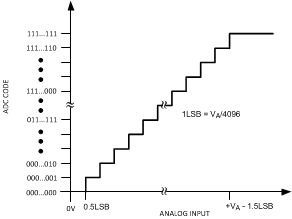 Figure 36. Ideal Transfer Characteristic
Figure 36. Ideal Transfer Characteristic
7.3.3 Analog Inputs
An equivalent circuit for one of the input channels of the ADC128S022 is shown in Figure 37. Diodes D1 and D2 provide ESD protection for the analog inputs. The operating range for the analog inputs is 0 V to VA. Going beyond this range will cause the ESD diodes to conduct and result in erratic operation.
The capacitor C1 in Figure 37 has a typical value of 3 pF and is mainly the package pin capacitance. Resistor R1 is the ON-resistance of the multiplexer and track / hold switch and is typically 500 Ω. Capacitor C2 is the ADC128S022 sampling capacitor, and is typically 30 pF. The ADC128S022 will deliver best performance when driven by a low-impedance source (less than 100 Ω). This is especially important when using the ADC128S022 to sample dynamic signals. Also important when sampling dynamic signals is a bandpass or lowpass filter which reduces harmonics and noise in the input. These filters are often referred to as anti-aliasing filters.
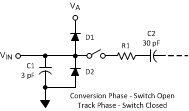 Figure 37. Equivalent Input Circuit
Figure 37. Equivalent Input Circuit
7.3.4 Digital Inputs and Outputs
The digital inputs of the ADC128S022 (SCLK, CS, and DIN) have an operating range of –0.3 V to VA. They are not prone to latch-up and may be asserted before the digital supply (VD) without any risk. The digital output (DOUT) operating range is controlled by VD. The output high voltage is VD – 0.5V (minimum) while the output low voltage is 0.4 V (maximum).
7.4 Device Functional Modes
The ADC128S022 is fully powered-up whenever CS is low and fully powered-down whenever CS is high, with one exception. If operating in continuous conversion mode, the ADC128S022 automatically enters power-down mode between SCLK's 16th falling edge of a conversion and SCLK's 1st falling edge of the subsequent conversion (see Figure 1).
In continuous conversion mode, the ADC128S022 can perform multiple conversions back to back. Each conversion requires 16 SCLK cycles and the ADC128S022 will perform conversions continuously as long as CS is held low. Continuous mode offers maximum throughput.
In burst mode, the user may trade off throughput for power consumption by performing fewer conversions per unit time. This means spending more time in power-down mode and less time in normal mode. By using this technique, the user can achieve very low sample rates while still using an SCLK frequency within the electrical specifications. The Power Consumption vs SCLK curve in the Typical Characteristics section shows the typical power consumption of the ADC128S022. To calculate the power consumption (PC), simply multiply the fraction of time spent in the normal mode (tN) by the normal mode power consumption (PN), and add the fraction of time spent in shutdown mode (tS) multiplied by the shutdown mode power consumption (PS) as shown in Equation 1.

7.5 Register Maps
Table 1. Control Register Bits
| Bit 7 (MSB) | Bit 6 | Bit 5 | Bit 4 | Bit 3 | Bit 2 | Bit 1 | Bit 0 |
|---|---|---|---|---|---|---|---|
| DONTC | DONTC | ADD2 | ADD1 | ADD0 | DONTC | DONTC | DONTC |
Table 2. Control Register Bit Descriptions
| BIT #: | SYMBOL: | DESCRIPTION |
|---|---|---|
| 7, 6, 2, 1, 0 | DONTC | Don't care. The values of these bits do not affect the device. |
| 5 | ADD2 | These three bits determine which input channel will be sampled and converted at the next conversion cycle. The mapping between codes and channels is shown in Table 3. |
| 4 | ADD1 | |
| 3 | ADD0 |
Table 3. Input Channel Selection
| ADD2 | ADD1 | ADD0 | INPUT CHANNEL |
|---|---|---|---|
| 0 | 0 | 0 | IN0 (Default) |
| 0 | 0 | 1 | IN1 |
| 0 | 1 | 0 | IN2 |
| 0 | 1 | 1 | IN3 |
| 1 | 0 | 0 | IN4 |
| 1 | 0 | 1 | IN5 |
| 1 | 1 | 0 | IN6 |
| 1 | 1 | 1 | IN7 |